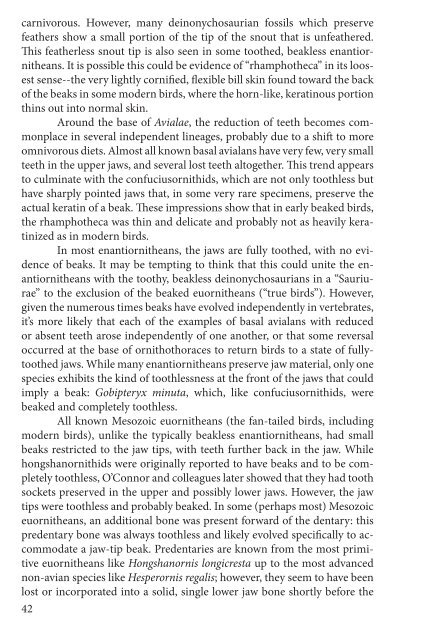You also want an ePaper? Increase the reach of your titles
YUMPU automatically turns print PDFs into web optimized ePapers that Google loves.
carnivorous. However, many deinonychosaurian fossils which preserve<br />
feathers show a small portion of the tip of the snout that is unfeathered.<br />
This featherless snout tip is also seen in some <strong>to</strong>othed, beakless enantiornitheans.<br />
It is possible this could be evidence of “rhamphotheca” in its loosest<br />
sense--the very lightly cornified, flexible bill skin found <strong>to</strong>ward the back<br />
of the beaks in some modern <strong>birds</strong>, where the horn-like, keratinous portion<br />
thins out in<strong>to</strong> normal skin.<br />
Around the base of Avialae, the reduction of teeth becomes commonplace<br />
in several independent lineages, probably due <strong>to</strong> a shift <strong>to</strong> more<br />
omnivorous diets. Almost all known basal avialans have very few, very small<br />
teeth in the upper jaws, <strong>and</strong> several lost teeth al<strong>to</strong>gether. This trend appears<br />
<strong>to</strong> culminate with the confuciusornithids, which are not only <strong>to</strong>othless but<br />
have sharply pointed jaws that, in some very rare specimens, preserve the<br />
actual keratin of a beak. These impressions show that in early beaked <strong>birds</strong>,<br />
the rhamphotheca was thin <strong>and</strong> delicate <strong>and</strong> probably not as heavily keratinized<br />
as in modern <strong>birds</strong>.<br />
In most enantiornitheans, the jaws are fully <strong>to</strong>othed, with no evidence<br />
of beaks. It may be tempting <strong>to</strong> think that this could unite the enantiornitheans<br />
with the <strong>to</strong>othy, beakless deinonychosaurians in a “Sauriurae”<br />
<strong>to</strong> the exclusion of the beaked euornitheans (“true <strong>birds</strong>”). However,<br />
given the numerous times beaks have evolved independently in vertebrates,<br />
it’s more likely that each of the examples of basal avialans with reduced<br />
or absent teeth arose independently of one an<strong>other</strong>, or that some reversal<br />
occurred at the base of ornithothoraces <strong>to</strong> return <strong>birds</strong> <strong>to</strong> a state of fully<strong>to</strong>othed<br />
jaws. While many enantiornitheans preserve jaw material, only one<br />
species exhibits the kind of <strong>to</strong>othlessness at the front of the jaws that could<br />
imply a beak: Gobipteryx minuta, which, like confuciusornithids, were<br />
beaked <strong>and</strong> completely <strong>to</strong>othless.<br />
All known Mesozoic euornitheans (the fan-tailed <strong>birds</strong>, including<br />
modern <strong>birds</strong>), unlike the typically beakless enantiornitheans, had small<br />
beaks restricted <strong>to</strong> the jaw tips, with teeth further back in the jaw. While<br />
hongshanornithids were originally reported <strong>to</strong> have beaks <strong>and</strong> <strong>to</strong> be completely<br />
<strong>to</strong>othless, O’Connor <strong>and</strong> colleagues later showed that they had <strong>to</strong>oth<br />
sockets preserved in the upper <strong>and</strong> possibly lower jaws. However, the jaw<br />
tips were <strong>to</strong>othless <strong>and</strong> probably beaked. In some (perhaps most) Mesozoic<br />
euornitheans, an additional bone was present forward of the dentary: this<br />
predentary bone was always <strong>to</strong>othless <strong>and</strong> likely evolved specifically <strong>to</strong> accommodate<br />
a jaw-tip beak. Predentaries are known from the most primitive<br />
euornitheans like Hongshanornis longicresta up <strong>to</strong> the most advanced<br />
non-avian species like Hesperornis regalis; however, they seem <strong>to</strong> have been<br />
lost or incorporated in<strong>to</strong> a solid, single lower jaw bone shortly before the<br />
42



